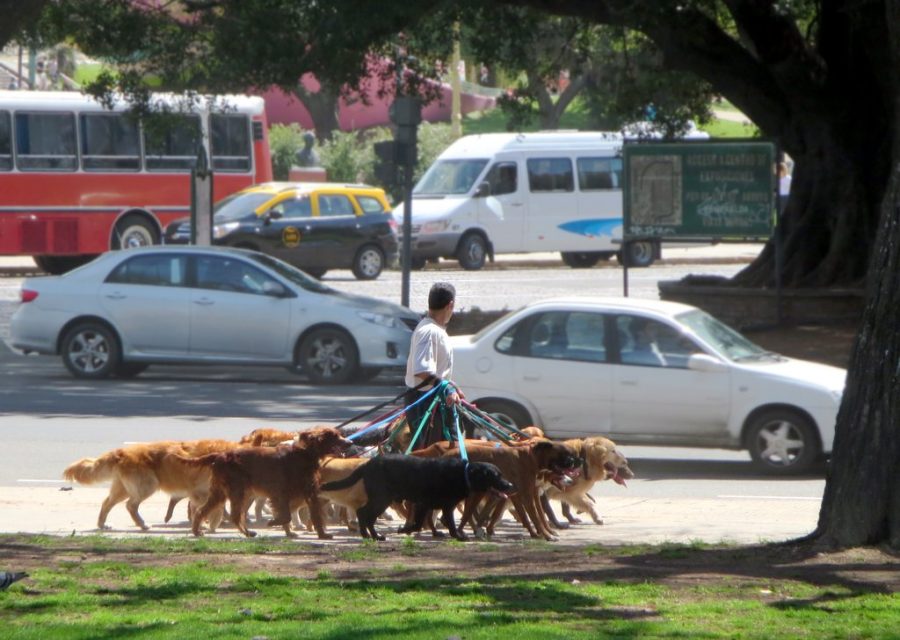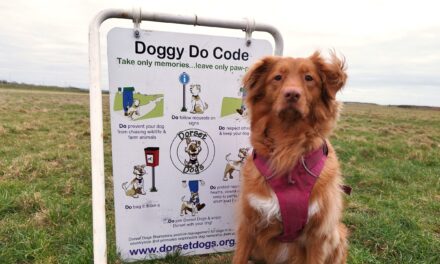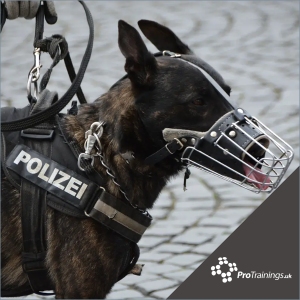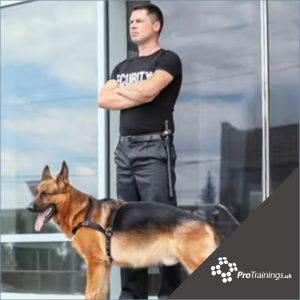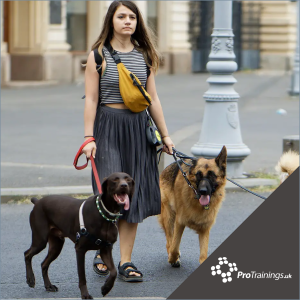Many of us have seen scenes when people are walking multiple dogs at the same time. Sometimes, even regular people do it. For example, Robin Scherbatsky in How I Met Your Mother. But is it really that easy? Can anyone do it? How do you walk multiple dogs at once?
When walking multiple dogs, a professional dog walker must consider the size, age, temperament, and breed of each individual dog.
Let’s be honest for a moment. It is not easy to walk big dogs like Rottweilers, German Shepherds and similar all at once. But it is doable.
The Importance of Organization
The most important aspect of walking multiple dogs at once is organization. A professional dog walker should prepare beforehand for the group dog walks.You must invest time learning the temperament of each individual dog, and then group them together so that there is no fighting and aggression between them. You certainly want to avoid a painful situation, right? Now, you might be wondering, where and how do you start?
There are a couple of things one must consider. For starters, puppies are naturally more energetic than older dogs. They will stop to sniff something at one place and then sprint to say hello to someone or run off chasing a bird.
Another factor you have to consider is that some dogs do not want to walk in groups. Before you can start a group walk, you have to introduce all canines to each other. Make sure they become friends before you try a group walk.
Dogs that socialize with each other can walk together. Dogs that haven’t seen each other beforehand cannot walk together.
Establishing yourself as the leader of the pack
The most important aspect of walking multiple dogs at once is establishing yourself as the leader of the pack. All dogs are pack animals, and they look up to someone for guidance. And if you do not be the one to guide the pack, some dog in the pack will try to get that role.
The dogs should see you as the leader, the one who is in charge. If any of the dogs or clients think otherwise, you will have incidents. And you will get dragged all over the place.
You cannot physically overpower more dogs. Imagine having to walk a combined weight of 400 pounds of dogs at once. How much do you weigh?
To establish yourself as a leader, you have to invest time in foundation training and building communication and trust with the dogs you are walking.
Dogs operate on a hierarchical social structure. That dates back to their history as descendants of wolves, and to their domesticated breeds. In that hierarchy, those at the top believe they do not have to follow any rules, except those below. If you are the number one in the pack, the ones below you will follow your guidance.
Dog breeds vary in submissiveness. On one hand you have Golden Retrievers and Labrador Retrievers, dogs that are eager to please, and on the other there are dominant breeds like Akita, Jack Russell Terrier, Siberian Husky and so on. Regardless, all dogs require a firm and strict alpha owner and leader.
How to adopt an alpha-first mentality?
Pet parents and dog walkers that want to be successful in walking and training their dogs have to learn how to adopt the mindset of an alpha dog. And that is always being first. The mindset applies to both outside and inside time. Here are some tips on how to adopt that mentality.
- When your dog challenges or disobeys you, control your emotions. Dogs rely on body language, and if you succumb to their challenge, dogs will not see you as the dominant person
- Initiate and stop play when you want, on your terms. If the dog is the one initiating play, do not fall for it. Wait for a few seconds, and then initiate. Teach your dog playtime depends on your terms
- A simple trick to stop jumping, a dominant dog behavior is to move toward your pet when it is trying to jump on you. This will force the dog to sit back in a submissive state, and then you reward
- Communicate using your body language. Use your emotions and actions along with verbal commands to deliver a clear message. If your voice command says one thing, and your body language a different one, the message is not clear
- Ask dogs to stay down every now and then, give them a timeout, and set yourself as the one who decides when is the time for a specific activity
- Do simple things like stopping dogs and walking first out of the door
- Control access to all doorways and narrow openings
- Control aspects of feeding arrangements, humans eat first, and then dogs
How to make sure dogs are happy, and not stressed
To be a successful dog walker, dogs should return home tired and happy. That makes pet parents pleased. Now, some dogs are social by nature, and they love group walks. Others are not so social and friendly. Walking with other dogs might be a nerve-wracking experience for some dogs.
So, how can you make these group walks exciting, entertaining, and pleasing for everyone involved? Here are some ideas.
Learn something new
Walking a dog doesn’t mean you have to just walk him around the block and that is it? When you are walking multiple dogs, try to engage the dogs in some training. Learning something new is a great way to engage the dogs in mental stimulation activities.
Let dogs sniff around
Walks can get annoying fast if dogs stop and sniff every five seconds. But that is where your alpha personality comes into play. Remember, for dogs, each smell is fascinating. So, while you cannot allow every dog in the group to smell every five seconds, you can make sniffing pauses.
Stop at some locations where dogs can use their nose and explore the environment.
Encourage play
If you have a group of dogs that enjoy spending time together, let them play. Encourage play between dogs. But do not force it. Not all dogs love to play with each other. Try to play some games that involve multiple dogs.
Use the environment to your advantage
A fallen tree can be a fun way to build some confidence in your dog and play. Simply get a dog to sit and wait on the fallen tree. It adds something new to the walk, and reward with treats afterward.
Use every object in the environment as a way to build confidence in dogs. Walking up and down the stairs, jumping on objects, and everything else. Search for some simple dog parkour exercises on Google for inspiration.
Change of pace
Changing the pace is a great way to get your dog’s attention. It adds value to the walk and helps you become a better alpha leader.
So, a great way to make sure your dogs are paying attention to you and the walk is to speed up, slow down, and change direction.
You can even add commands/cues for changing pace, like “quick” and “slow”.
How Many Dogs can you Walk at Once?
According to guidelines set by the Royal Society for the Prevention of Cruelty to Animals, the maximum number of dogs that can be walked at any one time should not exceed the number stated in the walker’s insurance policy and comply with local authority requirements.
Generally speaking, the recommendation is that a dog walker should not walk more than four dogs at any one time.
While it is not uncommon to see dog walkers with 6, 8, 10, or even more dogs, that is an insane challenge.
By limiting yourself to four dogs, you can prevent problems and accidents.
Possible Challenges that Might Arise
When you see a person walking multiple dogs in movies and television series, you think it is easy. But it is not. Walks never go as smoothly as you would like to. When walking multiple dogs, responsibilities multiply.
You are not always walking dogs of identical size, temperament, and breed. With that being said, here are some challenges that might arise.
Dogs throwing tantrums
You cannot have 100% reliable dogs. There will always be distractions, but it is your job to take charge of the situation.
How do you do that? Place the more stable and less physical dogs in the middle of the pack, while the animated dogs are on the edge.
You can also make stops during the walk to allow the canines to enjoy the scenery. We mentioned sniff breaks before, remember?
Walking on different sides
In the beginning, dogs will walk on either your left or right side. It is your job and responsibility to choose one side, and always walk dogs on that side. Over time, pets will learn what the side they can walk on is.
Getting into a fight
As we said before, there is no such thing as a 100% reliable dog. Fights are a reality, and they might occur at one point or another.
It is important that you do not panic. If you panic, you will make the situation worse. The best way to stop a fight is to get your dogs in a sit-stay position. But you have to work on that before the fight arises.
Screaming and yelling will add fuel to the fight, so try to avoid it. Another trick you can use is to pull back in a circular motion, carefully, and not release the dogs until they have calmed down.
Leash tangles
Leash tangles are another common problem when walking multiple dogs. When this happens, stop in, track your dog, and tell them to stay. When they stop walking, quickly untangle the leashes.
Cleaning up
As we said before, things multiply when you walk multiple dogs. That means more droppings. A piece of advice. Keep poop bags open in your belt pouch. This will help you save time. When you have to clean up after one dog, command the others to stay.
Tips for Success
Before we wrap it up, let’s go over some tips that will ensure you are successful in walking multiple dogs and keeping them entertained.
- Use the right equipment, there are two necessities, a suitable collar/harness, and a dog leash. Ensure each dog has a durable leash and appropriate collar
- Work with each dog individually
- Use the slowest dog in the pack as the pacesetter. Do not tailor the walk for the highest-energy dog. Others will suffer
- Most importantly, bring treats, plenty of them, and reward positive behaviors
Final Words
Walking multiple dogs is not only tricky and challenging, but it can also be dangerous as well. Being prepared is critical. If you know the dogs you are walking and trained them properly to understand your cues and commands, you are ready for such a challenge.
It is crucial that you build a good walking relationship with each dog separately. Taking a misbehaved puppy on a walk will be frustrating, but more importantly, dangerous.
Aleksandar Mishkov is a 36-year old dog enthusiast. He has been living with dogs his entire life, and nowadays, he shares his life with a 6 year old Jack Russell Terrier, Milo. Visit Aleksander at his website The Daily Tail where he shares helpful tips on how to train and make sure your dog behaves properly.

